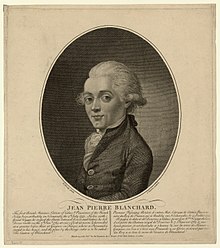This article needs additional citations for verification. (January 2022) |
Jean-Pierre Blanchard | |
|---|---|
 Jean-Pierre Blanchard, engraving after a portrait by Richard Livesay | |
| Born | 4 July 1753 |
| Died | 7 March 1809 (aged 55) |
| Nationality | French |
| Occupation | Inventor |
| Known for | Ballooning |
| Spouse(s) | Victoire Lebrun {abandoned} Marie Madeleine-Sophie Armant |
Jean-Pierre [François] Blanchard (French pronunciation: [ʒɑ̃ pjɛʁ blɑ̃ʃaʁ]; 4 July 1753 – 7 March 1809) was a French inventor, best known as a pioneer of gas balloon flight, who distinguished himself in the conquest of the air in a balloon. Notable for his successful hydrogen balloon flight in Paris on 2 March 1784, Blanchard later moved to London and undertook flights with varying propulsion mechanisms. His historic achievement came on 7 January 1785, crossing the English Channel from Dover Castle to Guînes in about 2½ hours, receiving acclaim from Louis XVI and earning a substantial pension.
Touring Europe, Blanchard demonstrated his balloons and showcased the modern parachute, which he later used for a successful escape in 1793 when his hydrogen balloon ruptured. In 1793, he conducted the first balloon flight in the Americas, witnessed by President George Washington. Married to Sophie Blanchard in 1804, Blanchard suffered a fatal heart attack in his balloon in 1808, with his widow continuing balloon demonstrations until her accidental death.